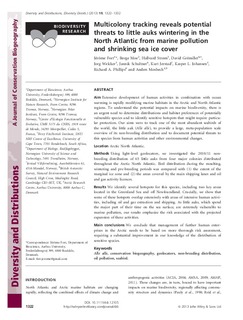Multicolony tracking reveals potential threats to little auks wintering in the North Atlantic from marine pollution and shrinking sea ice cover
Fort, Jérôme; Moe, Børge; Strøm, Hallvard; Grémillet, David; Welcker, Jorg; Schultner, Jannik; Jerstad, Kurt; Johansen, Kasper L.; Phillips, Richard A.; Mosbech, Anders
Journal article, Peer reviewed
Published version

Åpne
Permanent lenke
http://hdl.handle.net/11250/2624367Utgivelsesdato
2013Metadata
Vis full innførselSamlinger
- Institutt for biologi [2612]
- Publikasjoner fra CRIStin - NTNU [38525]
Originalversjon
Diversity and Distributions: A journal of biological invasions and biodiversity. 2013, 19 (10), 1322-1332. 10.1111/ddi.12105Sammendrag
Aim Extensive development of human activities in combination with ocean warming is rapidly modifying marine habitats in the Arctic and North Atlantic regions. To understand the potential impacts on marine biodiversity, there is an urgent need to determine distributions and habitat preferences of potentially vulnerable species and to identify sensitive hotspots that might require particular protection. Our aims were to track one of the most abundant seabirds of the world, the little auk (Alle alle), to provide a large, meta-population scale overview of its non-breeding distribution and to document potential threats to this species from human activities and other environmental changes. Location Arctic North Atlantic. Methods Using light-level geolocators, we investigated the 2010/11 nonbreeding distribution of 65 little auks from four major colonies distributed throughout the Arctic North Atlantic. Bird distribution during the moulting, wintering and pre-breeding periods was compared with (1) the extent of the marginal ice zone and (2) the areas covered by the main shipping lanes and oil and gas activity licences. Results We identify several hotspots for this species, including two key areas located in the Greenland Sea and off Newfoundland. Crucially, we show that some of these hotspots overlap extensively with areas of intensive human activities, including oil and gas extraction and shipping. As little auks, which spend the major part of their time on the sea surface, are extremely vulnerable to marine pollution, our results emphasize the risk associated with the projected expansion of these activities. Main conclusions We conclude that management of further human enterprises in the Arctic needs to be based on more thorough risk assessment, requiring a substantial improvement in our knowledge of the distribution of sensitive species. Alle alle, conservation biogeography, geolocators, non-breeding distribution, oil pollution, seabird.